
What to Expect from 2021
We just said goodbye to 2020, and we’re all hoping to be saying good riddance to COVID-19 soon. Brexit is also now “done,” and there will be a new president in the U.S. shortly.
It’s fair to say that 2021 should be very different from last year. But how?
A few trends will probably continue
Despite how unusual 2020 was, there are a few trends that persisted in 2020 and will likely continue into 2021.
- One of those is the popularity of inflows into ETFs. During 2020 a new record, of over $507 billion, flowed into U.S.-listed ETFs.
- Another consistent trend was the outflows from U.S. equity mutual funds (Chart 1).
- Index funds continued to gain market share from active funds.
Some think these trends are related, with new ETFs taking assets from old fashioned mutual funds, especially because the quantum of flows has roughly offset for years. However, a mix of data indicates they might be separate trends.
Chart 1: ETF inflows and U.S. equity mutual fund outflows continue, but they’re likely not related
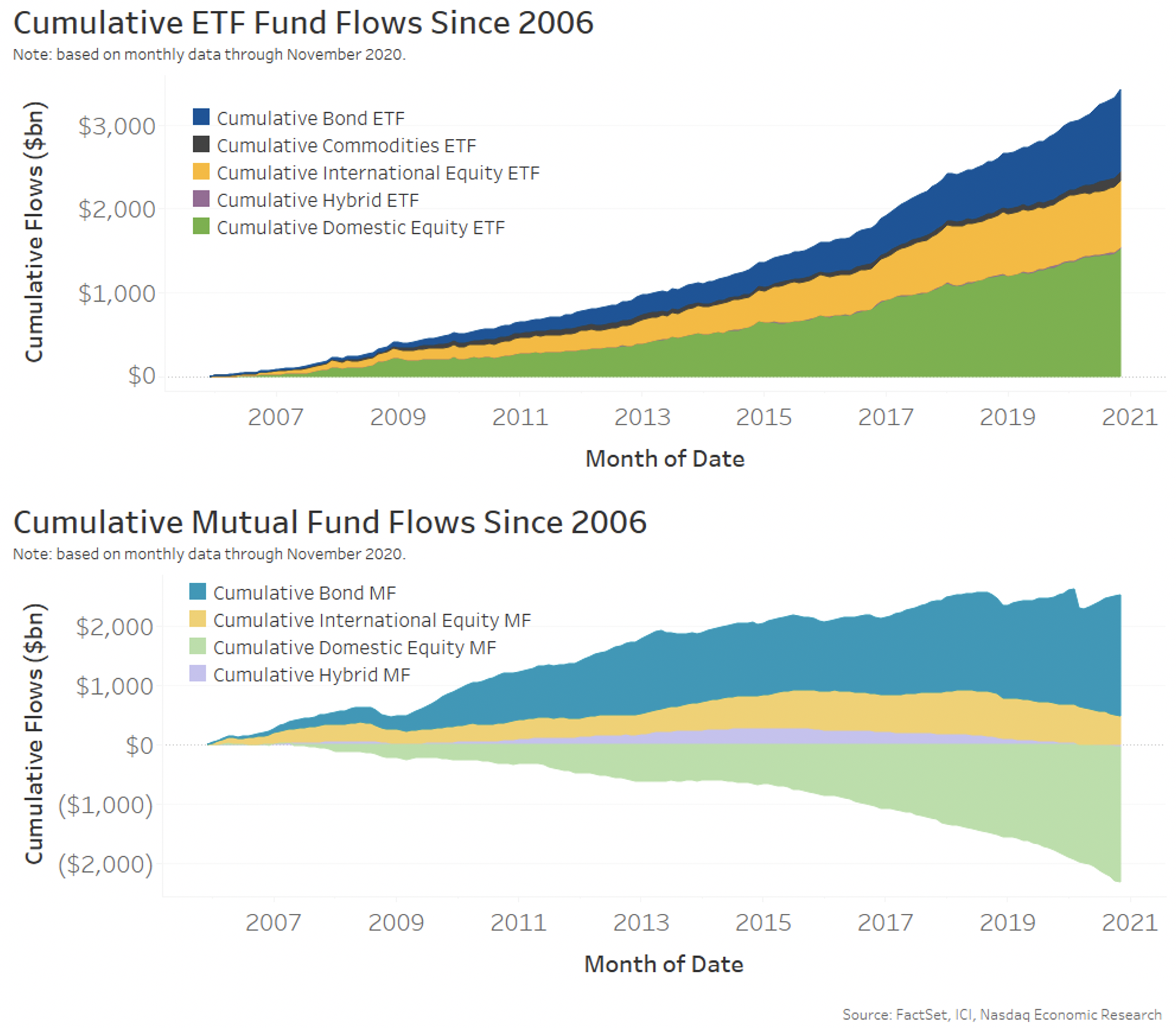
Consider the fact that ETFs are self-directed investments and a favorite trade for retail accounts, while mutual funds are mostly held long term in retirement accounts.
Data also shows a large proportion of the ETF flows are headed to international stocks and bond ETFs, so it’s not a simple U.S. equity mutual fund replacement.
In addition, the active to index trend is occurring in both ETFs and mutual funds.
Perhaps most compelling is the fact that outflows from U.S. equity mutual funds are roughly offset by inflows into bond and international stock mutual funds (Chart 1).
Based on these patterns, it’s more likely that ETFs and mutual funds operate in different segments of the market, with flows driven more by demographics than costs.
A possible permanent increase in retail volumes
Typically, trading volumes increase when volatility increases, and we had no shortage of uncertainty and volatility in 2020. However, as volatility subsided (see Chart 2), volumes have remained elevated in both stock and option markets:
- Stocks traded an average of 7 billion shares per day for 2019, but rarely traded that low in 2020, averaging over 10 billion shares per day, even well after the market had recovered.
- Equity options market volumes grew nearly 60% to 27.7 million average daily contacts (ADC) from 2019’s 17.5 million ADC.
Some of the persistence in high volumes is likely due to the growth in retail trading we saw in 2020. Triggered by free commissions back in Q4 of 2019, and then boosted by stimulus checks and people working from home, Main Street investors contributed to elevated volumes in stocks and options markets. Thanks to how retail trades, it also resulted in an increasingly large proportion of off-exchange stock trading.
Chart 2: Increased retail likely boosted stock and option liquidity
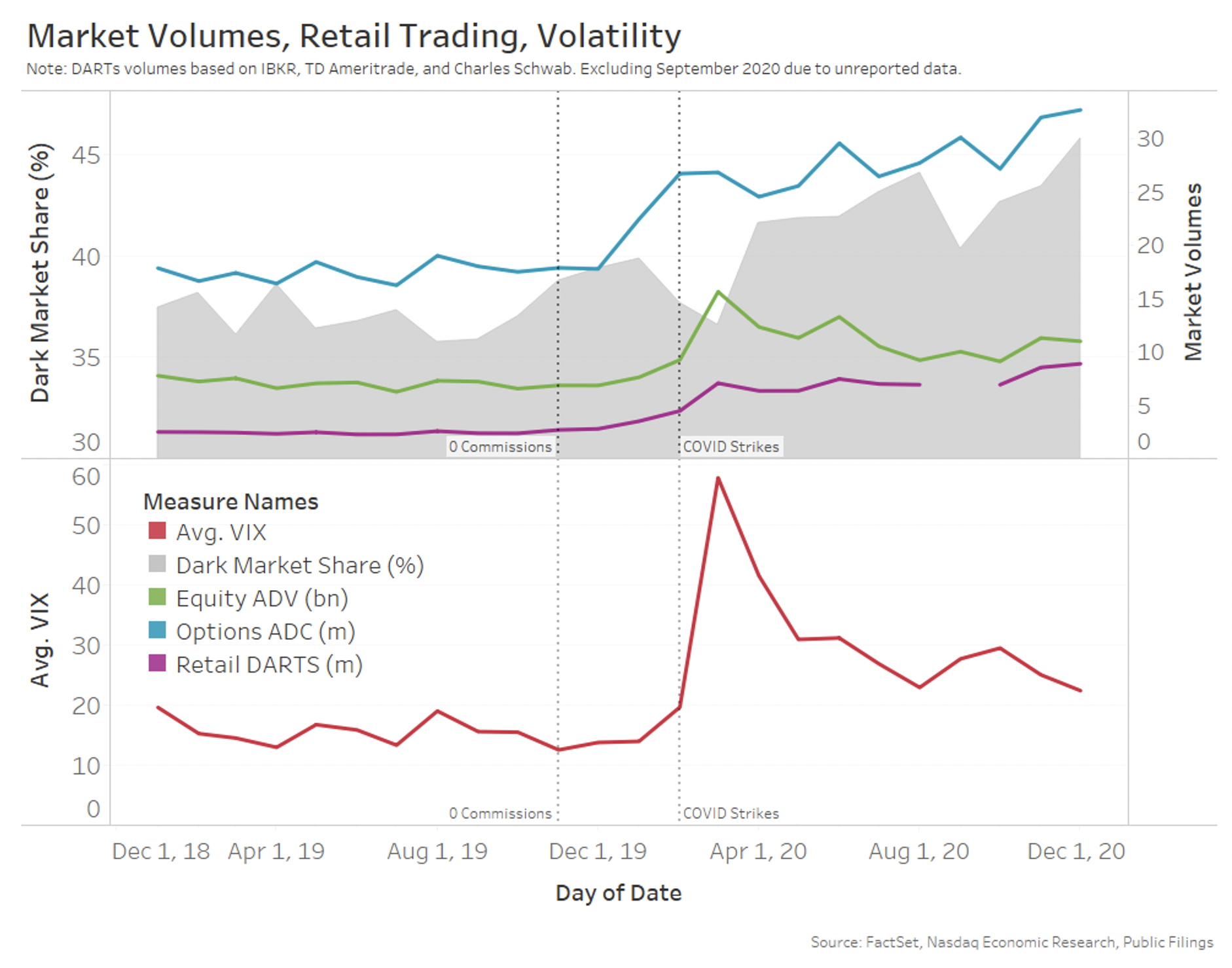
We saw this trend before, in the early 2000s, as markets electronified and spreads collapsed to decimals. That led to dramatic reductions in trading costs, which resulted in trading volumes increasing from around 1 billion shares per day to more than 5 billion shares per day.
The only thing that might stop this increase in liquidity that is if governments use a Financial Transaction Tax (FTT) to plug a fiscal hole, increasing trading costs. We showed this year that additional trading taxes lead to permanent reductions in liquidity and declines in market values. That’s bad for the recovery, as it increases companies’ costs of, and access to, capital.
Regulators dealing with unintended consequences (or “Clean up in Aisle Five”)
Speaking of missteps: as off-exchange market share naturally increased last year, regulators also made moves to push even more trading off public markets.
New accredited investor rules allowed more investors to buy private companies. For most investors who are limited to listed stocks, NMS II changes were designed to make public quotes worth less. Then, the approval of speed bump quotes created a situation where slow venues can use those cheaper quotes to grab market share and more profits at the expense of price-setting markets.
In 2021, investors will see liquidity segment further and public prices will fade on some more than others, creating a less equal market.
Ironically, just as the SEC has claimed to make the SIP faster and more equal, those quotes will matter less to many. The new SEC will need to deal with the unintended consequences of 2020’s new rules.
An uneven recovery
With stocks closing near all-time highs and a strong IPO market, investors and issuers were among the winners from 2020. But the recovery was far from even.
As stimulus was added to the system, stocks recovered. That pushed spending on goods back above pre-COVID levels, which in turn helped the manufacturing sector. So much so that commodity price gains are starting to increase input costs for manufacturers (but more on inflation later).
Despite a stellar manufacturing recovery, employment lagged. That’s partly because manufacturing now only accounts for around 10% of employment. The much larger services sector was more exposed to the social distancing that combating the coronavirus requires. The entertainment industry, restaurants, travel and brick-and-mortar retail are all big employers, but they’ve seen big and persistent drops in spending.
Chart 3: Goods spending is above pre-COVID levels, but services spending is holding net spending back
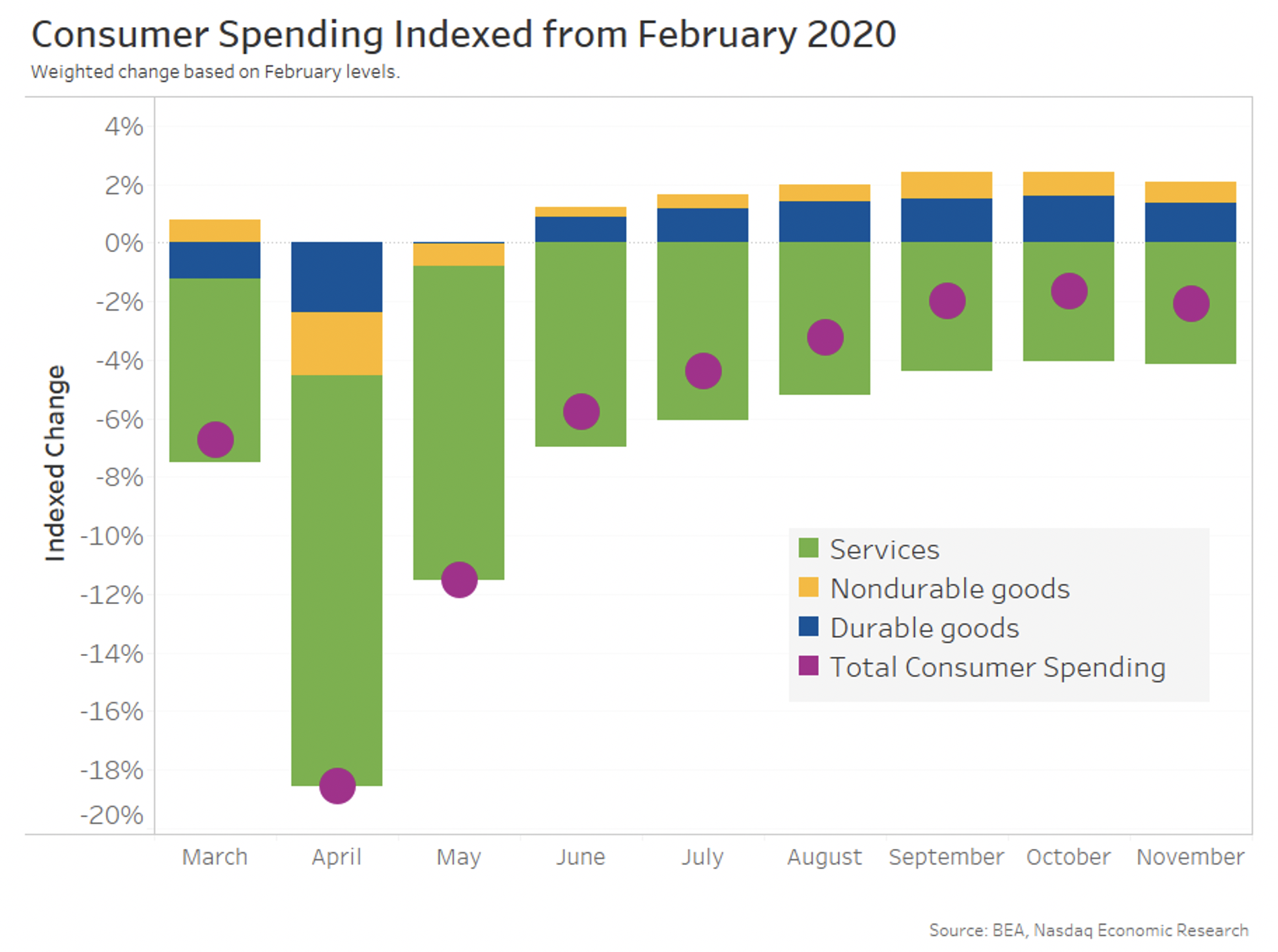
Valuations need low rates for longer
That dispersion in exposure to COVID was reflected in relative returns in 2020. Oil and energy stocks closed the year down 36.9%, with demand for oil stalled at around 10% below pre-COVID levels. Real estate was hurt by business closures and rent defaults.
In contrast, sectors positioned for vaccine research and work (or gaming, shopping and watching TV) from home were the winners.
Chart 4: Not all sectors and asset classes were winners in 2020
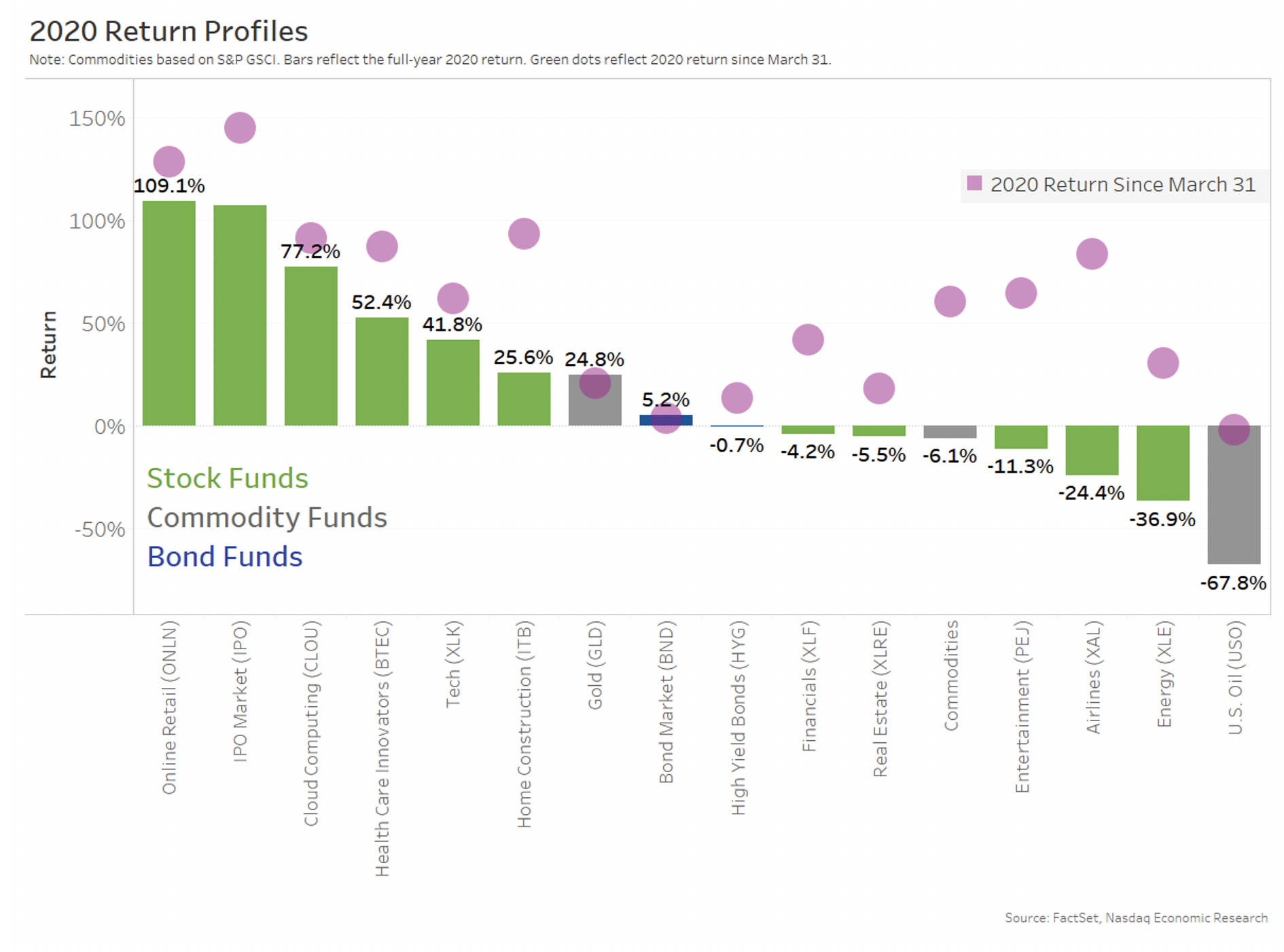
What this doesn’t explain is the record high close of the overall market, especially given the slump in earnings. Those overall gains have mostly come because of two factors:
- An expected recovery in earnings during 2021, with the market expecting a quick recovery in earnings, especially as vaccines roll out.
- Multiple expansion (higher PE ratios) which can be justified based on record low interest rates (Chart 5).
Chart 5: Justifying valuations: Current PEs are consistent with the record low risk-free rate
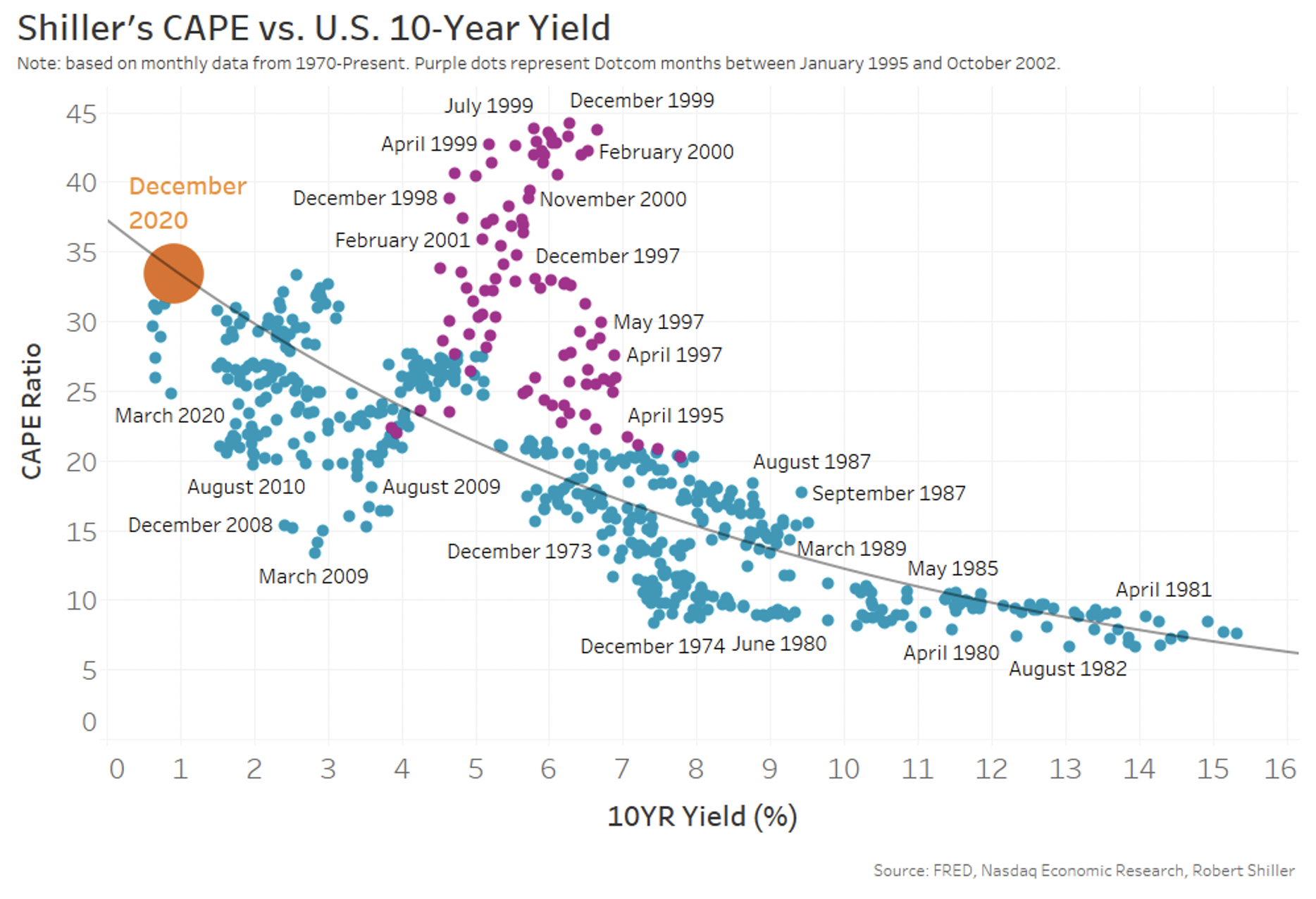
Longer-term trends show that higher valuations (PE ratios) usually occur in an economy with lower “risk-free” rates. Only the tech bubble defies that trend (pink dots in Chart 5) and in hindsight, those stocks were over-valued.
Stock valuation math supports this trend too. With lower rates, future cash flows discounted less. That leads to higher valuations, especially for growth stocks with more of their earnings in the future. Thought of another way, with low borrowing costs, more low-earning companies will be profitable, after borrow costs, in the future.
But that also highlights two risks for 2021. One is a failure or delay in the vaccine. The other is that rates rise, requiring PE’s to adjust back down the black curve (Chart 5).
Inflation risks
The Fed has said they expect to keep rates very low for a long time. They even loosened their inflation targets to give them more time before tightening.
Inflation would seem the biggest risk to rates, but many think it is still unlikely.
Some point to demographics (shrinking populations) or technology as overarching deflationary influences that will keep inflation at bay. Others believe the excess capacity currently available would make it hard to generate enough demand to raise prices.
But rarely in the past have we seen these wartime levels of debt, and such a dramatic increase in the money supply without causing follow-on inflation. As COVID has progressed, net savings have accumulated. Those with jobs have had less to spend their money on while others have banked some of the more than $1 trillion in stimulus payments. Savings rates confirm this.
If we see a fast recovery from COVID-19 in 2021, a sudden increase in demand for services has the potential to push prices higher, even if only temporarily. That could generate enough inflation for rates to rise. In fact, rates are rising already.
Rising rates in 2021 would likely add to stock volatility, and may put pressure on valuations, unless earnings are rising with inflation too.
Value could be the real winner
One winner from a rising rate environment may be value stocks. With record low rates, growth stocks have outperformed value by more than at any time in the past 60-plus years. Valuations of value stocks won’t be as sensitive to rising rates, given their more mature revenues and margins.
Chart 6: Value is at a multi-decade record discount to growth stocks
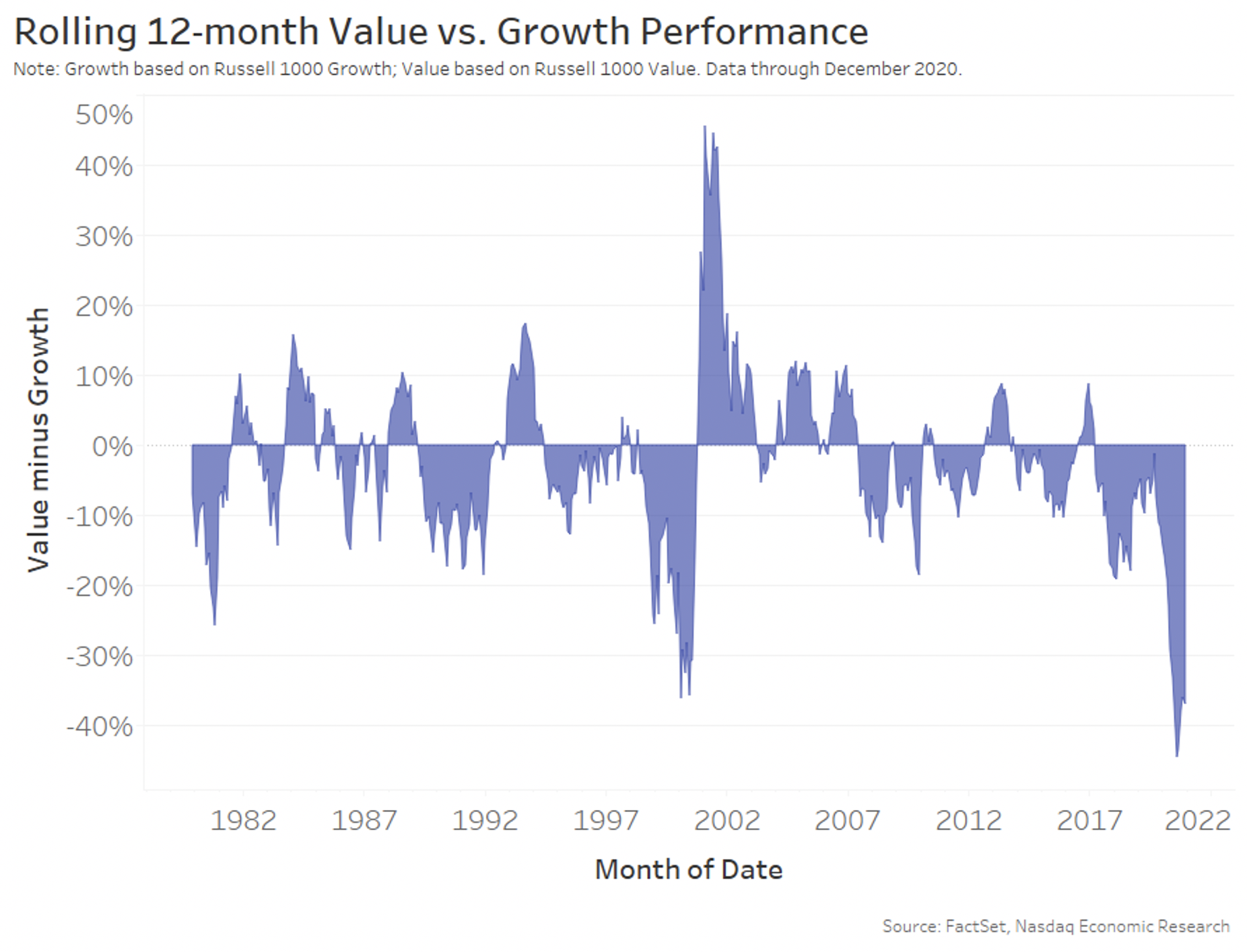
COVID policy is economic policy
As well as hurting many families, COVID-19 has left its mark on the economy. Record levels of stimulus, wartime-level debt and Depression-era unemployment will be challenges to ride out.
So far, stocks have fared well, with the stimulus and savings priming the system and rates at record lows.
There are reasons for optimism. But there are also new risks ahead.
We can be confident of this: 2021 is unlikely to be like 2020, and that’s a good thing.
